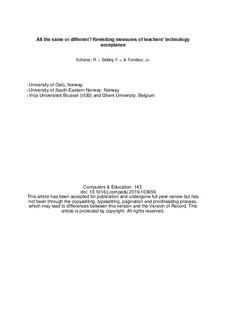All the same or different? Revisiting measures of teachers' technology acceptance
Journal article, Peer reviewed
Accepted version
Permanent lenke
http://hdl.handle.net/11250/2611766Utgivelsesdato
2020Metadata
Vis full innførselSamlinger
Sammendrag
Technology acceptance has been widely discussed and examined in educational contexts. Despite the variety of models and measures describing teachers' technology acceptance, two key assumptions persist in the existing body of literature: First, the technology acceptance construct can be represented by a set of diverse, yet correlated attitudes and beliefs. Second, the effects of technology acceptance on the intentions to use technology and technology use—two commonly studied outcome variables—follow a cascade. The existing evidence backing these assumptions is, however, diverse, as the considerable between-study variation in the relations between the technology acceptance and outcome variables shows. This variation remained largely unexplained, and the present study offers an explanation from the perspective of construct validity. Analyzing a large meta-analytic sample (N = 37211 teachers) obtained from a previous meta-analysis, we synthesized the correlations among measures of teachers' technology acceptance and found support for the existence of a common trait that underlies all technology acceptance variables. This finding remained even after distinguishing between different teacher samples (i.e., pre-vs. in-service teachers) and types of technology (i.e., technology in general vs. specific technologies). There was no convincing evidence for the hypothesized cascade of effects, due to a weak and insignificant link between usage intentions and technology use. Our findings provide evidence for the representation of teachers' technology acceptance as a single latent variable and consequently offer a way to describe its relations to usage intentions and technology use without compromising the validity of the inferences drawn from them.
Beskrivelse
CC-BY-NC-ND

